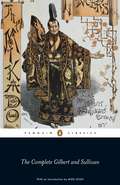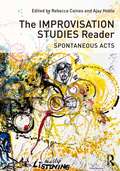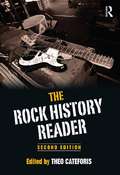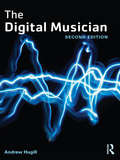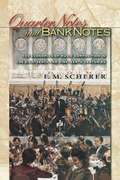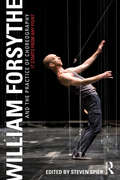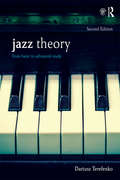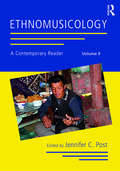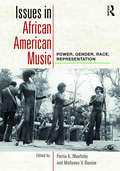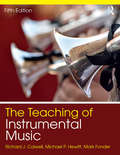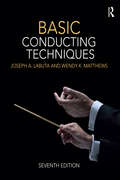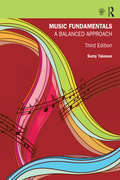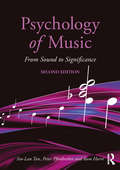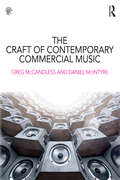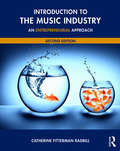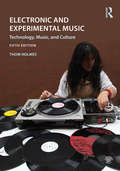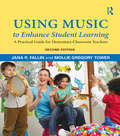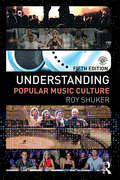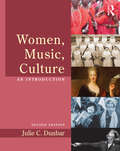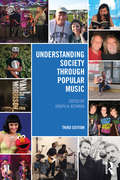- Table View
- List View
The Savoy Operas: The Complete Gilbert and Sullivan (Penguin Classics)
by Arthur Sullivan W. S. Gilbert Ed Glinert Mike LeighGilbert and Sullivan’s operas are some of the world’s best-loved musical works, delighting audiences with their joyous wit, topsy-turvy logic and extravagant wordplay. This glorious treasury is the definitive annotated edition of all fourteen of their operas. From the partially lost work Thespis, the first collaboration between W. S. Gilbert and Arthur Sullivan, through the triumphant comic romps The Pirates of Penzance and The Mikado, to lesser-performed gems such as the fanciful The Sorcerer and the acerbic lampoon Patience, Gilbert’s libretti are collected here in their most accurate and faithful form. There is a fascinating commentary on each work, telling the extraordinary stories behind the inspiration for the opera and its performance history, and giving plot summaries and original cast lists.
The Improvisation Studies Reader: Spontaneous Acts
by Ajay Heble Rebecca CainesImprovisation is a performance practice that animates and activates diverse energies of inspiration, critique, and invention. In recent years it has coalesced into an exciting and innovative new field of interdisciplinary scholarly inquiry, becoming a cornerstone of both practical and theoretical approaches to performance. The Improvisation Studies Reader draws together the works of key artists and thinkers from a range of disciplines, including theatre, music, literature, film, and dance. Divided by keywords into eight sections, this book bridges the gaps between these fields. The book includes case studies, exercises, graphic scores and poems in order to produce a teaching and research resource that identifies central themes in improvisation studies. The sections include: Listening Trust/Risk Flow Dissonance Responsibility Liveness Surprise Hope Each section of the Reader is introduced by a newly commissioned think piece by a key figure in the field, which opens up research questions reflecting on the keyword in question. By placing key theoretical and classic texts in conversation with cutting-edge research and artists’ statements, this book answers the urgent questions facing improvising artists and theorists in the mediatized Twenty-First Century.
The Improvisation Studies Reader: Spontaneous Acts
by Ajay Heble Rebecca CainesImprovisation is a performance practice that animates and activates diverse energies of inspiration, critique, and invention. In recent years it has coalesced into an exciting and innovative new field of interdisciplinary scholarly inquiry, becoming a cornerstone of both practical and theoretical approaches to performance. The Improvisation Studies Reader draws together the works of key artists and thinkers from a range of disciplines, including theatre, music, literature, film, and dance. Divided by keywords into eight sections, this book bridges the gaps between these fields. The book includes case studies, exercises, graphic scores and poems in order to produce a teaching and research resource that identifies central themes in improvisation studies. The sections include: Listening Trust/Risk Flow Dissonance Responsibility Liveness Surprise Hope Each section of the Reader is introduced by a newly commissioned think piece by a key figure in the field, which opens up research questions reflecting on the keyword in question. By placing key theoretical and classic texts in conversation with cutting-edge research and artists’ statements, this book answers the urgent questions facing improvising artists and theorists in the mediatized Twenty-First Century.
The Rock History Reader
by Theo CateforisThe Rock History Reader is an eclectic compilation of readings that tells the history of rock as it has been received and explained as a social and musical practice throughout its six decade history. The readings range from the vivid autobiographical accounts of such rock icons as Ronnie Spector and David Lee Roth to the writings of noted rock critics like Lester Bangs and Chuck Klosterman. It also includes a variety of selections from media critics, musicologists, fanzine writers, legal experts, sociologists and prominent political figures. Many entries also deal specifically with distinctive styles such as Motown, punk, disco, grunge, rap and indie rock. Each entry includes headnotes, which place it in its historical context. This second edition includes new readings on the early years of rhythm & blues and rock ‘n’ roll, as well as entries on payola, mods, the rise of FM rock, progressive rock and the PMRC congressional hearings. In addition, there is a wealth of new material on the 2000s that explores such relatively recent developments as emo, mash ups, the explosion of internet culture and new media, and iconic figures like Radiohead and Lady Gaga. With numerous readings that delve into the often explosive issues surrounding censorship, copyright, race relations, feminism, youth subcultures, and the meaning of musical value, The Rock History Reader continues to appeal to scholars and students from a variety of disciplines.
The Rock History Reader
by Theo CateforisThe Rock History Reader is an eclectic compilation of readings that tells the history of rock as it has been received and explained as a social and musical practice throughout its six decade history. The readings range from the vivid autobiographical accounts of such rock icons as Ronnie Spector and David Lee Roth to the writings of noted rock critics like Lester Bangs and Chuck Klosterman. It also includes a variety of selections from media critics, musicologists, fanzine writers, legal experts, sociologists and prominent political figures. Many entries also deal specifically with distinctive styles such as Motown, punk, disco, grunge, rap and indie rock. Each entry includes headnotes, which place it in its historical context. This second edition includes new readings on the early years of rhythm & blues and rock ‘n’ roll, as well as entries on payola, mods, the rise of FM rock, progressive rock and the PMRC congressional hearings. In addition, there is a wealth of new material on the 2000s that explores such relatively recent developments as emo, mash ups, the explosion of internet culture and new media, and iconic figures like Radiohead and Lady Gaga. With numerous readings that delve into the often explosive issues surrounding censorship, copyright, race relations, feminism, youth subcultures, and the meaning of musical value, The Rock History Reader continues to appeal to scholars and students from a variety of disciplines.
The Digital Musician
by Andrew HugillThe Digital Musician is a textbook for creative music technology and electronic music courses. It provides an overview of sound properties, acoustics, digital music, and sound design as a basis for understanding the compositional possibilities that new music technologies allow. Creative projects allow students to apply key concepts covered in each chapter. Topics covered include hardware hacking, live coding, interactive music, sound manipulation and transformation, software instruments, networked performance, as well as critical listening and analysis. Features Readers Guides outline the major topics in each chapter Project boxes for both individuals and groups throughout each chapter Annotated Listening Lists for each chapter, with accompanying playlists on the companion website Recommended Further Reading and Discussion Questions at the end of each chapter Case studies of actual composers, with contributed projects Companion website includes reading lists, links to audio and video, and slides for use in the classroom.
The Digital Musician
by Andrew HugillThe Digital Musician is a textbook for creative music technology and electronic music courses. It provides an overview of sound properties, acoustics, digital music, and sound design as a basis for understanding the compositional possibilities that new music technologies allow. Creative projects allow students to apply key concepts covered in each chapter. Topics covered include hardware hacking, live coding, interactive music, sound manipulation and transformation, software instruments, networked performance, as well as critical listening and analysis. Features Readers Guides outline the major topics in each chapter Project boxes for both individuals and groups throughout each chapter Annotated Listening Lists for each chapter, with accompanying playlists on the companion website Recommended Further Reading and Discussion Questions at the end of each chapter Case studies of actual composers, with contributed projects Companion website includes reading lists, links to audio and video, and slides for use in the classroom.
Quarter Notes and Bank Notes: The Economics of Music Composition in the Eighteenth and Nineteenth Centuries (The Princeton Economic History of the Western World (PDF) #13)
by F. M. SchererIn 1700, most composers were employees of noble courts or the church. But by the nineteenth century, Chopin, Schumann, Brahms, Verdi, and many others functioned as freelance artists teaching, performing, and selling their compositions in the private marketplace. While some believe that Mozart's career marks a clean break between these two periods, this book tells the story of a more complex and interesting transition. F. M. Scherer first examines the political, intellectual, and economic roots of the shift from patronage to a freelance market. He describes the eighteenth-century cultural "arms race" among noble courts, the spread of private concert halls and opera houses, the increasing attendance of middle-class music lovers, and the founding of conservatories. He analyzes changing trends in how composers acquired their skills and earned their living, examining such impacts as demographic developments and new modes of transportation. The book offers insight into the diversity of composers' economic aspirations, the strategies through which they pursued success, the burgeoning music publishing industry, and the emergence of copyright protection. Scherer concludes by drawing some parallels to the economic state of music composition in our own times. Written by a leading economist with an unusually broad knowledge of music, this fascinating account is directed toward individuals intrigued by the world of classical composers as well as those interested in economic history or the role of money in art.
William Forsythe and the Practice of Choreography: It Starts From Any Point
by Steven SpierWilliam Forsythe’s reinvigoration of classical ballet during his 20-year tenure at the Ballett Frankfurt saw him lauded as one of the greatest choreographers of the postwar era. His current work with The Forsythe Company has gone even further to challenge and investigate fundamental assumptions about choreography itself. William Forsythe and the Practice of Choreography presents a diverse range of critical writings on his work, with illuminating analysis of his practice from an interdisciplinary perspective. The book also contains insightful working testaments from Forsythe’s collaborators, as well as a contribution from the choreographer himself. With essays covering all aspects of Forsythe’s past and current work, readers are provided with an unparalleled view into the creative world of this visionary artist, as well as a comprehensive resource for students, scholars, and practitioners of ballet and contemporary dance today.
Jazz Theory: From Basic to Advanced Study
by Dariusz TerefenkoJazz Theory: From Basic to Advanced Study, Second Edition, is a comprehensive textbook for those with no previous study in jazz, as well as those in advanced theory courses. Written with the goal to bridge theory and practice, it provides a strong theoretical foundation from music fundamentals to post-tonal theory, while integrating ear training, keyboard skills, and improvisation. It hosts "play-along" audio tracks on a Companion Website, including a workbook, ear-training exercises, and an audio compilation of the musical examples featured in the book. Jazz Theory is organized into three parts: Basics, Intermediate, and Advanced. This approach allows for success in a one-semester curriculum or with subsequent terms. If students sense that theory can facilitate their improvisational skills or can help them develop their ears, they become more engaged in the learning process. The overall pedagogical structure accomplishes precisely that in an original, creative—and above all, musical—manner. KEY FEATURES include 390 musical examples, ranging from original lead sheets of standard tunes, jazz instrumentals, transcriptions, and original compositions, to fully realized harmonic progressions, sample solos, and re-harmonized tunes. The completely revamped Companion Website hosts: 46 "Play Along Sessions" audio tracks, offering experiences close to real-time performance scenarios. Over 1,000 (audio and written) exercises covering ear training, rhythm, notation, analysis, improvisation, composition, functional keyboard, and others. Recordings of all 390 musical examples from the textbook. Links: Guide to Making Transcriptions, List of Solos to Transcribe, Selected Discography, Classification of Standard Tunes, and more. Lists of well-known standard tunes, including a comprehensive list of 999 Standard Tunes – Composers and Lyricists. NEW TO THE SECOND EDITION are instructors’ tools with answer keys to written and ear-training exercises, 380 rhythmic calisthenics featuring exercises from the swing, bebop, and Latin rhythmic traditions, a new improvisation section, a set of 140 Comprehensive Keyboard exercises, plus an expanded ear-training section with 125 melodic, 50 rhythmic dictations, and 170 harmonic dictations, plus 240 written exercises, 25 composition assignments, and 110 singing exercises.
Ethnomusicology: A Contemporary Reader, Volume II
by Jennifer C. PostEthnomusicology: A Contemporary Reader, Volume II provides an overview of developments in the study of ethnomusicology in the twenty-first century, offering an introduction to contemporary issues relevant to the field. Nineteen essays, written by an international array of scholars, highlight the relationship between current issues in the discipline and ethnomusicologists’ engagement with issues such as advocacy, poverty and social participation, maintaining intangible cultural heritages, and ecological concerns. It provides a forum for rethinking the discipline’s identity in terms of major themes and issues to which ethnomusicologists have turned their attention since Volume I published in 2005. The collection of essays is organized into six sections: Property and Rights Applied Practice Knowledge and Agency Community and Social Space Embodiment and Cognition Curating Sound Volume II serves as a basic introduction to the best writing in the field for students, professors, and music professionals, perfect for both introductory and upper level courses in world music. Together with the first volume, Ethnomusicology: A Contemporary Reader, Volume II provides a comprehensive survey of current research directions.
Issues in African American Music: Power, Gender, Race, Representation
by Portia K. Maultsby Mellonee V. BurnimIssues in African American Music: Power, Gender, Race, Representation is a collection of twenty-one essays by leading scholars, surveying vital themes in the history of African American music. Bringing together the viewpoints of ethnomusicologists, historians, and performers, these essays cover topics including the music industry, women and gender, and music as resistance, and explore the stories of music creators and their communities. Revised and expanded to reflect the latest scholarship, with six all-new essays, this book both complements the previously published volume African American Music: An Introduction and stands on its own. Each chapter features a discography of recommended listening for further study. From the antebellum period to the present, and from classical music to hip hop, this wide-ranging volume provides a nuanced introduction for students and anyone seeking to understand the history, social context, and cultural impact of African American music.
The Teaching of Instrumental Music
by Richard Colwell Michael Hewitt Mark FonderThe Teaching of Instrumental Music, Fifth Edition introduces music education majors to basic instrumental pedagogy for the instruments and ensembles commonly found in the elementary and secondary curricula. It focuses on the core competencies required for teacher certification in instrumental music, with the pervasive philosophy to assist teachers as they develop an instrumental music program based on understanding and respecting all types of music. Parts I and II focus on essential issues for a successful instrumental program, presenting first the history and foundations, followed by effective strategies in administrative tasks and classroom teaching. Parts III, IV, and V are devoted to the skills and techniques of woodwind, brass and percussion, and string instruments. In all, The Teaching of Instrumental Music is the complete reference for the beginning instrumental teacher, commonly retained in a student’s professional library for its unique and comprehensive coverage. NEW TO THIS EDITION: Revision and updating of curriculum developments, such as coordinating State Department of Education student learning objectives with the recent Every Student Succeeds Act (ESSA) New discussion of the NAfME National Standards as they relate to the teaching of instrumental music Revamping of rehearsing instrumental ensembles chapters, including new or expanded sections on programming, choosing quality music, and applying successful rehearsal techniques Updates on references, plus new discussion questions, and websites and internet links A chapter devoted to classroom guitar Updates on the use of technology for teaching and learning music More on healthy performance practice, marching band, and jazz band Online materials located in the eResources section on the Routledge website.
Basic Conducting Techniques
by Joseph A. Labuta Wendy K. MatthewsBasic Conducting Techniques, Seventh Edition, provides a clear and intelligible introduction to the art of conducting an ensemble. Over the course of fourteen chapters, the authors explicate the elements of conducting, supplementing their teachings with an extensive selection of musical examples from the classical repertoire. Practical and innovative, clear and approachable, this text illuminates the essential skills a beginning conductor should develop to lead and rehearse a performing group. This new edition features: chapters rewritten to highlight important information and show connections between different sections a new chapter on expressive conducting, consisting of expanded and updated content select full scores in the "Musical Excerpts" section excerpts with transpositions for each chapter, allowing easy access for class performance a new companion website, which includes the scores and transpositions for all musical excerpts, audio recordings of the excerpts, and demonstration videos modeling specific techniques for each chapter. With the beginning conductor in mind, this hands-on, competency-centered approach is appropriate for mixed classes of choral and instrumental music majors, providing indispensable versatility for students and practicing conductors alike. Rooted in decades of teaching and conducting experience, Basic Conducting Techniques is the essential guide to the principles of conducting.
Music Fundamentals: A Balanced Approach
by Sumy TakesueMusic Fundamentals: A Balanced Approach, Third Edition combines a textbook and integrated workbook with an interactive website for those who want to learn the basics of reading music. Intended for students with little or no prior knowledge of music theory, it offers a patient approach to understanding and mastering the building blocks of musical practice and structure. Musical examples range from Elvis Presley songs to Filipino ballads to Beethoven symphonies, offering a balanced mixture of global, classical, and popular music. The new edition includes: Additional vocabulary features and review exercises Additional musical selections and 1-, 2-, or 3-hand rhythmic exercises The addition of guitar tablature A revised text design that more clearly designates the different types of exercises and makes the Workbook pages easier to write on An improved companion website with added mobile functionality The author’s balanced approach to beginning music theory engages student interest while demonstrating how music theory concepts apply not only to the Western classical canon but also to popular and world music. With the beginner student in mind, Music Fundamentals: A Balanced Approach, Third Edition is a comprehensive text for understanding the foundations of music theory.
Psychology of Music: From Sound to Significance
by Siu-Lan Tan Peter Pfordresher Rom HarréIn Psychology of Music: From Sound to Significance (2nd edition), the authors consider music on a broad scale, from its beginning as an acoustical signal to its different manifestations across cultures. In their second edition, the authors apply the same richness of depth and scope that was a hallmark of the first edition of this text. In addition, having laid out the topography of the field in the original book, the second edition puts greater emphasis on linking academic learning to real-world contexts, and on including compelling topics that appeal to students’ natural curiosity. Chapters have been updated with approximately 500 new citations to reflect advances in the field. The organization of the book remains the same as the first edition, while chapters have been updated and often expanded with new topics. 'Part I: Foundations' explores the acoustics of sound, the auditory system, and responses to music in the brain. 'Part II: The Perception and Cognition of Music' focuses on how we process pitch, melody, meter, rhythm, and musical structure. 'Part III: Development, Learning, and Performance' describes how musical capacities and skills unfold, beginning before birth and extending to the advanced and expert musician. And finally, 'Part IV: The Meaning and Significance of Music' explores social, emotional, philosophical and cultural dimensions of music and meaning. This book will be invaluable to undergraduates and postgraduate students in psychology and music, and will appeal to anyone who is interested in the vital and expanding field of psychology of music.
The Craft of Contemporary Commercial Music
by Greg McCandless Daniel McIntyreIn the contemporary world, the role of the commercial composer has grown to include a wide range of new responsibilities. Modern composers not only write music, but also often need to perform, record, and market their own works. The Craft of Contemporary Commercial Music prepares today’s music students for their careers by teaching them to compose their own music, produce it professionally, and sell it successfully. The textbook integrates three areas of concentration—music theory and composition, audio engineering, and music business—allowing students to understand and practice how to successfully navigate each stage of a score’s life cycle from concept to contract. Students will learn how to: Translate musical ideas into scores utilizing music theory and composition techniques Transform scores into professional audio through the production stages of tracking, sequencing, editing, mixing, mastering, and bouncing Market works to prospective clients The textbook assumes no prior knowledge of music theory or audio topics, and its modular organization allows instructors to use the book flexibly. Exercises at the end of each chapter provide practice with key skills, and a companion website supports the book with video walkthroughs, streaming audio, a glossary, and printable exercise pages. Combining a grounding in music notation and theory concepts with a foundation in essential technologies, The Craft of Contemporary Commercial Music offers an innovative approach that addresses the needs of students preparing for music careers.
Introduction to the Music Industry: An Entrepreneurial Approach, Second Edition
by Catherine Fitterman RadbillIntroduction to the Music Industry: An Entrepreneurial Approach, Second Edition is an introductory textbook that offers a fresh perspective in one of the fastest-changing businesses in the world today. It engages students with creative problem-solving activities, collaborative projects and case studies as they explore the inner workings of the music business, while encouraging them to think like entrepreneurs on a path toward their own successful careers in the industry. This new edition includes a revised chapter organization, with chapters streamlined to focus on topics most important to music business students, while also maintaining its user-friendly chapter approach. Supported by an updated companion website, this book equips music business students and performance majors with the knowledge and tools to adopt and integrate entrepreneurial thinking successfully into practice and shape the future of the industry.
Electronic and Experimental Music: Technology, Music, and Culture (Media And Popular Culture Ser.)
by Thom HolmesElectronic and Experimental Music: Technology, Music, and Culture provides a comprehensive history of electronic music, covering key composers, genres, and techniques used in analog and digital synthesis. This textbook has been extensively revised with the needs of students and instructors in mind. The reader-friendly style, logical organization, and pedagogical features of the fifth edition allow easy access to key ideas, milestones, and concepts. New to this edition: • A companion website, featuring key examples of electronic music, both historical and contemporary. • Listening Guides providing a moment-by-moment annotated exploration of key works of electronic music. • A new chapter—Contemporary Practices in Composing Electronic Music. • Updated presentation of classic electronic music in the United Kingdom, Italy, Latin America, and Asia, covering the history of electronic music globally. • An expanded discussion of early experiments with jazz and electronic music, and the roots of electronic rock. • Additional accounts of the vastly under-reported contributions of women composers in the field. • More photos, scores, and illustrations throughout. The companion website features a number of student and instructor resources, such as additional Listening Guides, links to streaming audio examples and online video resources, PowerPoint slides, and interactive quizzes.
Electronic and Experimental Music: Technology, Music, and Culture
by Thom HolmesElectronic and Experimental Music: Technology, Music, and Culture provides a comprehensive history of electronic music, covering key composers, genres, and techniques used in analog and digital synthesis. This textbook has been extensively revised with the needs of students and instructors in mind. The reader-friendly style, logical organization, and pedagogical features of the fifth edition allow easy access to key ideas, milestones, and concepts. New to this edition: • A companion website, featuring key examples of electronic music, both historical and contemporary. • Listening Guides providing a moment-by-moment annotated exploration of key works of electronic music. • A new chapter—Contemporary Practices in Composing Electronic Music. • Updated presentation of classic electronic music in the United Kingdom, Italy, Latin America, and Asia, covering the history of electronic music globally. • An expanded discussion of early experiments with jazz and electronic music, and the roots of electronic rock. • Additional accounts of the vastly under-reported contributions of women composers in the field. • More photos, scores, and illustrations throughout. The companion website features a number of student and instructor resources, such as additional Listening Guides, links to streaming audio examples and online video resources, PowerPoint slides, and interactive quizzes.
Using Music to Enhance Student Learning: A Practical Guide for Elementary Classroom Teachers
by Jana Fallin Mollie Gregory TowerIntegrating musical activities in the elementary school classroom can assist in effectively teaching and engaging students in Language Arts, Science, Math, and Social Studies, while also boosting mental, emotional and social development. However, many elementary education majors fear they lack the needed musical skills to use music successfully. Future elementary school teachers need usable, practical musical strategies to easily infuse into their curriculum. Written for both current and future teachers with little or no previous experience in music, Using Music to Enhance Student Learning, 2nd Edition offers strategies that are not heavily dependent on musical skills. While many textbooks are devoted to teaching music theory skills, this textbook is dedicated to pedagogy – the actual teaching of music – particularly in those schools without a separate music class in their curriculum. The ultimate goal is for future teachers to provide their elementary school classes with engaging learning experiences. These learning experiences are clearly presented to enable children to acquire knowledge in all subject areas within a joyful, creative environment rich with music activities. New to the second edition are the animated listening maps, more audio tracks, a new guitar unit, expanded coverage in the recorder unit, a connection with visual art and music, expanded activities in American history and math, and updated research and statistics. SPECIAL FEATURES Animated "Listening Maps" help listeners focus on music selections through clear visual representations of sound. Group Activities reinforce the social aspects of music-making, as well as the benefits of collaborative teaching and learning. A thorough integration of music in the curriculum establishes that music is essential in a child’s development, and that the incorporation of music will enhance all other subjects/activities in the classroom. Learning Aids include "Tantalizing Tidbits of Research," which provide the justifications for why these activities are important, as well as "Teaching Tips," and "Thinking It Through" activities. The Using Music Package Streamed listening selections from the Baroque, Classical, Romantic, and Contemporary Periods Get America Singing…Again! Volume 1 (developed in association with the Music Educators National Conference, now NAFME, and other music organizations) with 43 songs that represent America’s varied music heritage of folk, traditional, and patriotic themes Appendices include a songbook with Hispanic folksongs, a recorder music songbook and a guitar unit Companion website hosts various teaching and learning resources
Using Music to Enhance Student Learning: A Practical Guide for Elementary Classroom Teachers
by Jana Fallin Mollie Gregory TowerIntegrating musical activities in the elementary school classroom can assist in effectively teaching and engaging students in Language Arts, Science, Math, and Social Studies, while also boosting mental, emotional and social development. However, many elementary education majors fear they lack the needed musical skills to use music successfully. Future elementary school teachers need usable, practical musical strategies to easily infuse into their curriculum. Written for both current and future teachers with little or no previous experience in music, Using Music to Enhance Student Learning, 2nd Edition offers strategies that are not heavily dependent on musical skills. While many textbooks are devoted to teaching music theory skills, this textbook is dedicated to pedagogy – the actual teaching of music – particularly in those schools without a separate music class in their curriculum. The ultimate goal is for future teachers to provide their elementary school classes with engaging learning experiences. These learning experiences are clearly presented to enable children to acquire knowledge in all subject areas within a joyful, creative environment rich with music activities. New to the second edition are the animated listening maps, more audio tracks, a new guitar unit, expanded coverage in the recorder unit, a connection with visual art and music, expanded activities in American history and math, and updated research and statistics. SPECIAL FEATURES Animated "Listening Maps" help listeners focus on music selections through clear visual representations of sound. Group Activities reinforce the social aspects of music-making, as well as the benefits of collaborative teaching and learning. A thorough integration of music in the curriculum establishes that music is essential in a child’s development, and that the incorporation of music will enhance all other subjects/activities in the classroom. Learning Aids include "Tantalizing Tidbits of Research," which provide the justifications for why these activities are important, as well as "Teaching Tips," and "Thinking It Through" activities. The Using Music Package Streamed listening selections from the Baroque, Classical, Romantic, and Contemporary Periods Get America Singing…Again! Volume 1 (developed in association with the Music Educators National Conference, now NAFME, and other music organizations) with 43 songs that represent America’s varied music heritage of folk, traditional, and patriotic themes Appendices include a songbook with Hispanic folksongs, a recorder music songbook and a guitar unit Companion website hosts various teaching and learning resources
Understanding Popular Music Culture
by Roy ShukerThis extensively revised and expanded fifth edition of Understanding Popular Music Culture provides an accessible and comprehensive introduction to the production, distribution, consumption and meaning of popular music, and the debates that surround popular culture and popular music. Reflecting the continued proliferation of popular music studies, the new music industry in a digital age, and the emergence of new stars, this new edition has been reorganized and extensively updated throughout, making for a more coherent and sequenced coverage of the field. These updates include: two new chapters entitled ‘The Real Thing’: Authenticity, covers and the canon and ‘Time Will Pass You By’: Histories and popular memory new case studies on artists including The Rolling Stones, Lorde, One Direction and Taylor Swift further examples of musical texts, genres, and performers throughout including additional coverage of Electronic Dance Music expanded coverage on the importance of the back catalogue and the box set; reality television and the music biopic greater attention to the role and impact of the internet and digital developments in relation to production, dissemination, mediation and consumption; including the role of social network sites and streaming services each chapter now has its own set of expanded references to facilitate further investigation. Additional resources for students and teachers can also be found on the companion website (www.routledge.com/cw/shuker), which includes additional case studies, links to relevant websites and a discography of popular music metagenres.
Women, Music, Culture: An Introduction
by Julie C. DunbarWomen, Music, Culture: An Introduction, Second Edition is the first undergraduate textbook on the history and contribution of women in a variety of musical genres and professions, ideal for students in courses in both music and women's studies. A compelling narrative, accompanied by over 50 guided listening examples, brings the world of women in music to life, examining a community of female musicians, including composers, producers, consumers, performers, technicians, mothers, and educators in art music and popular music. The book features a wide array of pedagogical aids, including a running glossary and a comprehensive companion website with streamed audio tracks, that help to reinforce key figures and terms. This new edition includes a major revision of the Women in World Music chapter, a new chapter in Western Classical "Work" in the Enlightenment, and a revised chapter on 19th Century Romanticism: Parlor Songs to Opera. 20th Century Art Music.
Understanding Society through Popular Music
by Joseph A. KotarbaWritten for Introductory Sociology and Sociology of Popular Music courses, this book uses popular music to illustrate fundamental social institutions, theories, sociological concepts, and processes. The authors use music, a social phenomenon of great interest, to draw students in and bring life to their study of social life.
